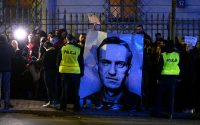Prosecutors Turn Sam Bankman-Fried’s Own Words Against Him
When the cryptocurrency exchange FTX was riding high, Sam Bankman-Fried, the company founder, communicated with the public in a relentless torrent of tweets, TV interviews and pronouncements in front of Congress.
Now as Mr. Bankman-Fried testifies in his own defense at his federal fraud trial in Manhattan, those words are coming back to haunt him.
On Monday, a federal prosecutor bombarded the disgraced cryptocurrency mogul with questions as he took the stand for the second time. Over an hour and a half in the morning, the prosecutor, Danielle Sassoon, grilled Mr. Bankman-Fried about the inconsistencies between his public statements and how he ran his crypto empire before it collapsed spectacularly in November.
Mr. Bankman-Fried, 31, wearing a light gray suit and purple tie, insisted that he couldn’t remember much of what he had said publicly. He added that he wasn’t significantly involved in the hedge fund he founded, Alameda Research.
“I’m not sure,” he responded over and over, as Ms. Sassoon asked about statements he had made when he was chief executive of FTX. “I can’t recall,” he said at other points.
The cross-examination exposed cracks in Mr. Bankman-Fried’s claims, dealing a potentially serious blow to his credibility with the jury of nine women and three men who will decide his fate. Ms. Sassoon displayed statements that appeared to show Mr. Bankman-Fried saying one thing in public, then acting differently in private. After having him recount FTX’s efforts to woo government officials in Washington, Ms. Sassoon asked him to repeat private messages in which he used an expletive to dismiss regulators as useless.
Mr. Bankman-Fried’s testimony was the most anticipated moment of a high-profile trial that has shone a spotlight on the hubris and rampant risk taking that caused the crypto industry to implode last year, erasing billions of dollars in savings. Once the face of crypto’s efforts to woo the public, Mr. Bankman-Fried is now widely compared to some of the most notorious fraudsters in recent history, including Elizabeth Holmes, the founder of the failed blood-testing start-up Theranos.
Taking the stand was risky. Criminal defendants usually avoid testifying so that prosecutors don’t have a chance to question them. But the first few weeks of the trial were so damaging for Mr. Bankman-Fried, as a procession of government witnesses testified that he lied to the public and stole from FTX customers, that he was left with few options to salvage the case.
In December, federal prosecutors charged Mr. Bankman-Fried with orchestrating a sweeping scheme to steal as much as $10 billion from FTX’s customers. They said he spent the money on extravagant projects, including venture capital investments, political contributions and luxury real estate purchases in the Bahamas, where FTX was based. Mr. Bankman-Fried was also accused of creating a secret backdoor in FTX’s code that allowed Alameda to seize billions of dollars in customer funds.
Not long after FTX imploded, three of Mr. Bankman-Fried’s closest associates — Caroline Ellison, Nishad Singh and Gary Wang — pleaded guilty to fraud and agreed to cooperate with the government, hoping for more lenient sentences. All three testified against Mr. Bankman-Fried at the trial, telling the jury that they lied and stole for years at his behest.
Mr. Bankman-Fried took the stand on Friday to tell his side of the story. He cast himself as a hard-working founder who was overwhelmed by his responsibilities and let major business issues go unaddressed. He denied that he committed fraud, and blamed his colleagues for many of the problems that led to FTX’s collapse.
On Monday, it was the prosecution’s turn to ask questions. The courtroom was packed with spectators, including Mr. Bankman-Fried’s parents, the law professors Joe Bankman and Barbara Fried, and Damian Williams, the top federal prosecutor in New York. Ms. Sassoon’s mother was also in attendance.
Ms. Sassoon focused many of her questions on Mr. Bankman-Fried’s statements to the media and Congress. She grilled him about interviews he gave in which he insisted that Alameda had no special privileges as a customer that traded on FTX. Over the first three weeks of the trial, prosecutors called a series of witnesses who testified that the opposite was true, and that Mr. Bankman-Fried channeled billions of dollars to Alameda.
Ms. Sassoon asked at one point, “Do you deny that Alameda was the only FTX customer” that accepted other people’s deposits into its bank accounts?
“I’m not sure,” Mr. Bankman-Fried replied.
Ms. Sassoon also asked the FTX founder whether he had assured the public that the exchange would keep its customers’ assets safe.
Mr. Bankman-Fried hemmed and hawed, saying he didn’t specifically recall. “I made a lot of public statements,” he said.
Ms. Sassoon then showed a tweet that Mr. Bankman-Fried had posted about that very issue. “And, as always, our users’ funds and safety come first,” he had written.


